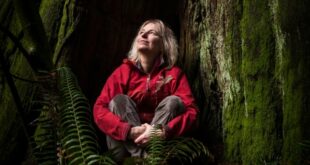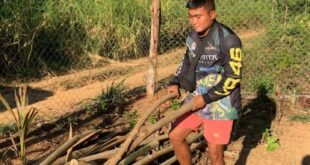With host Mae Martin, episode visits Royal Botanical Gardens and explores the ‘variety’ of examples around us.

The natural world is full of gender diversity: female hyenas have pseudo penises used for sex and urination, many species of fish and plants change their sex over their lifespan, and female lions have been known to grow manes and develop a masculine growl.
Those are among many examples in a new episode of CBC’s The Nature of Things titled Fluid: Life Beyond the Binary — a documentary hosted by Canadian comedian Mae Martin that puts the gender spectrum exhibited by humans in the context of the rest of the living things surrounding us, and finds that it’s really quite par for the course.
“Nature teaches us that there’s a lot of variety out there and generalizations are pretty impossible,” says Joan Roughgarden, an evolutionary biologist interviewed in the episode, who wrote a book called Evolution’s Rainbow.

Roughgarden says scientists long avoided probing gender diversity, which gave some the mistaken impression that it hasn’t always existed among many kinds of organisms, including humans.
But seeing the diversity among her own peers at events that celebrate gay pride made it clear to her that “there’s nothing the matter with the people. There’s something the matter with the science.”

The show, which airs Thursday on CBC and CBC Gem at 9 p.m. ET, includes numerous examples of gender and sexual diversity in the wild, such as:
-
Ruffs: a type of sandpiper found on the fjords of Norway. The male birds have many different appearances, including some that look the same as the females.
-
Bonobos: “I would call bonobos bisexual in that they have sex in all combinations,” said primatologist Frans de Waal, who was filmed for the show before his death on March 14 at the age of 75. “It is also quite common to find females who have masculine traits.” He described one female named Donna that he observed, who grew more masculine in her appearance as she aged, and was “extremely well accepted” among the males. “She was an individual who crossed the binary… Maybe she corresponds with what we would call a trans person in human society.”
-
Clownfish – a tropical species made famous by the animated family film Finding Nemo. Neuroscientist Justin Rhodes explains that “if the female is removed or gets displaced, the male will change sex and become a female. He explains that many fish species can change their biological sex — about 500, according to another part of the episode — but most often change from female to male, often within a week. The case of the clownfish is unique in that the physical changes can take years, leaving the fish in an “intermediate state” biologically while it begins to adopt female behaviour. “The gonads don’t define the sex of these animals… it’s happening in the brain.”
‘These are not outliers’
“It warms my heart because I see aspects of myself reflected in nature,” says host Martin, who is non-binary, noting science has come to accept widespread natural gender diversity.
“These are not outliers. This is the mainstream view.”

Mae Martin explores the science of gender and sexual fluidity in a new episode of The Nature of Things
‘Fluid: Life Beyond the Binary’ debunks dangerous pseudo-scientific myths and introduces cutting-edge research to reveal that in a very real and measurable sense, we are all gender fluid. Coming to CBC and CBC Gem on March 28, 2024.
The plant world is also rife with gender fluidity, says horticulturist Jon Peter, of the Royal Botanical Gardens (RBG) in Burlington, Ont.
Peter is featured in the episode discussing the red ginger, a tropical plant that is male in the mornings, producing pollen, and switches to female in the afternoons, moving to a state where its egg can be fertilized.
There are many local examples as well, Peter noted in an interview with CBC Hamilton this week:
-
Moosewood, or moose maple, start out as male when they’re young but can produce male and female flowers as they get older and then female flowers as they mature and get closer to the forest canopy. “When they’re young and juvenile, they are looking to set down their roots and get established. It doesn’t make sense for them to produce fruit.”
-
Spruce, which can have “female cones higher up in the canopy, and the lower branches will have male cones” on the same tree.
-
Jack-in-the-Pulpit, a forest plant that starts as a “non-sexual juvenile,” then becomes male, and turns female in later life.
While not indigenous to Ontario, ginkgo is widely cultivated here, including at the RBG. Peter says that while it has separate male and female trees, a branch or a whole tree can change to female if there aren’t other females around for pollination.

“A lot of this is really new to science, there’s not a lot out there about these processes,” he said, while proposing they may have evolved as a way to pass genetics on to the next generation.
“As that plant matures and is seeing its lifespan coming to an end, it thinks ‘I need to produce seed now.'”
‘Gender is a much wider spectrum than the two boxes’
The episode’s editor, Peter Topalovic, says he always learns something doing his job, whether it’s editing a baking show or Canada’s Got Talent, but says the episode taught him way more than he was expecting.
Topalovic, who grew up in Hamilton and went to Bishop Ryan Catholic Secondary School, says the show affirms the normalcy of all forms of gender expression and sexuality.
“When you look at the unbiased scientific findings, as we do in this documentary, you see that fluidity is not unusual at all,” he told CBC Hamilton in an interview.
“Gender is a much wider spectrum than the two boxes we put people in. There’s masculine, feminine and so much in between.”

He’s pleased that the wide reach of The Nature of Things will bring issues of gender to some people who may not have thought much about it before.
“I know that my older, Croatian parents will be tuning in to learn about a topic they otherwise wouldn’t be exposed to,” he said.
“With this documentary, I hope more trans people feel seen and more cis people feel compassion for them.”
ABOUT THE AUTHOR
Saira Peesker is a reporter with CBC Hamilton, with particular interests in climate, labour and local politics. She has previously worked with the Hamilton Spectator and CTV News, and is a regular contributor to the Globe and Mail, covering business and personal finance. Saira can be reached at saira.peesker@cbc.ca.
*****
Credit belongs to : www.cbc.ca
 Atin Ito First Filipino Community Newspaper in Ontario
Atin Ito First Filipino Community Newspaper in Ontario






